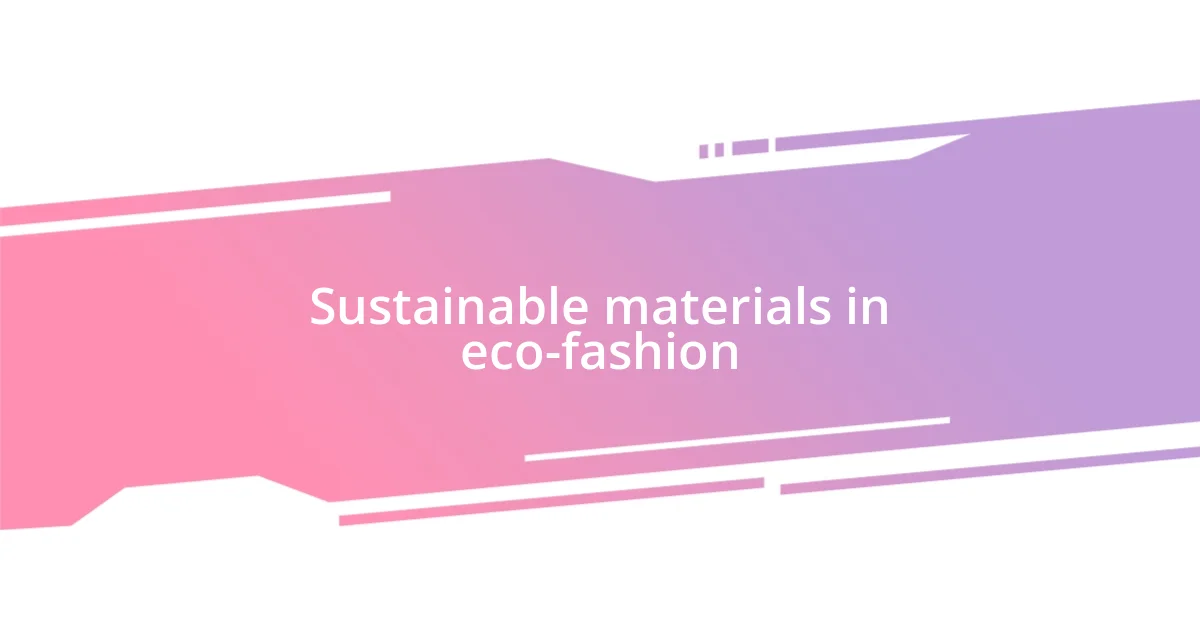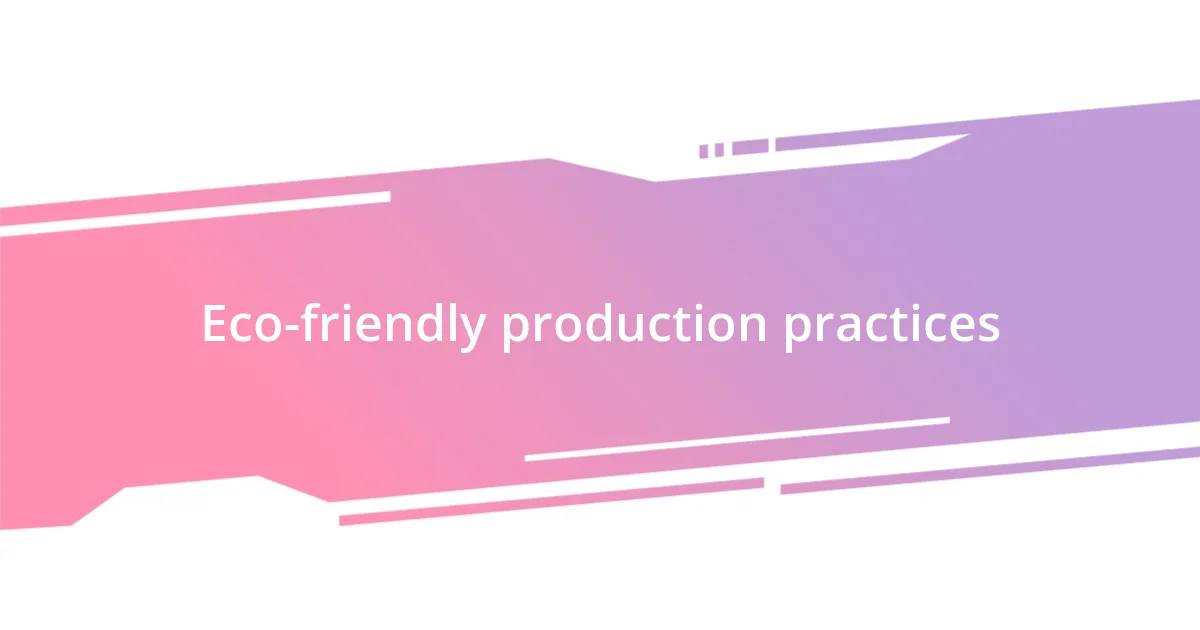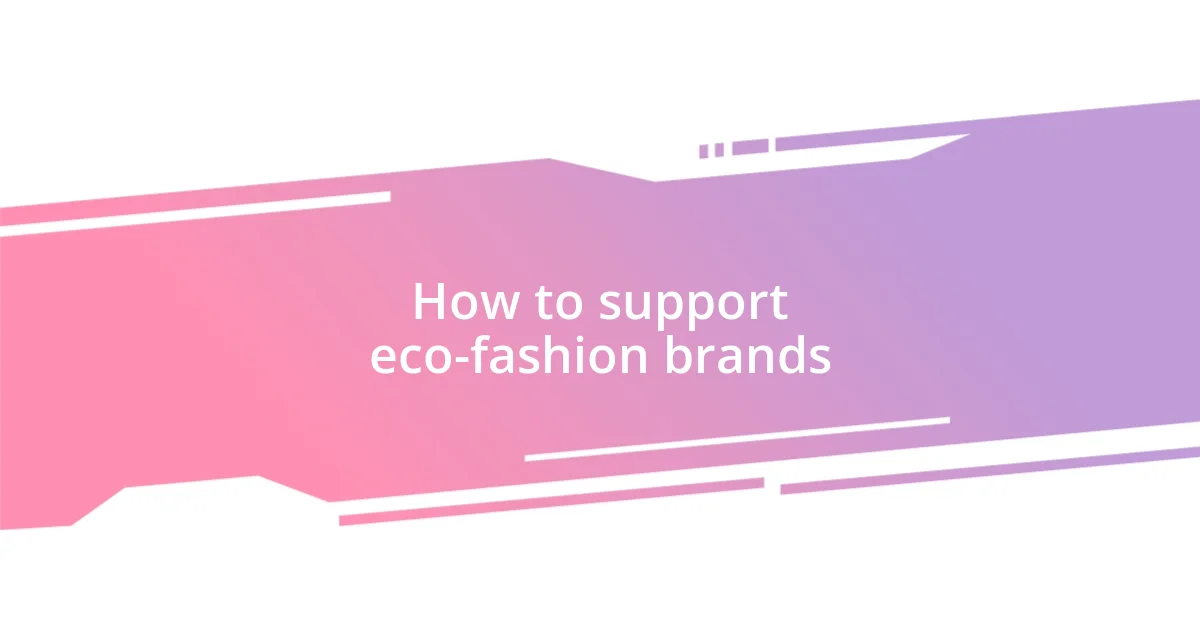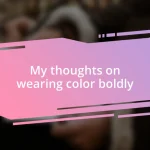Key takeaways:
- Eco-fashion emphasizes sustainability by promoting ethical practices, such as using organic materials and supporting fair labor conditions.
- Benefits of eco-fashion include reduced environmental impact, support for ethical practices, and fostering a sense of individuality and mindful consumption.
- Future trends in eco-fashion include biodesign, circular fashion, and technological innovations like 3D printing, which enhance sustainability and personalization in clothing production.

Understanding eco-fashion concepts
Eco-fashion is a movement that goes beyond mere aesthetics; it embodies a philosophy of sustainability in clothing production. I remember the first time I delved into this world; it felt like uncovering a treasure trove of creativity combined with responsibility. How often do we consider the impact of our wardrobe choices? Every piece of clothing carries a story, from the materials used to the labor behind its creation.
At the heart of eco-fashion lies the commitment to ethical practices, including the use of organic materials and fair labor conditions. I once attended a local pop-up shop featuring eco-friendly brands, and the passion of the designers was palpable. Do you think it’s essential for fashion to carry a message? For me, it’s imperative; wearing something that supports the planet feels like a personal pledge to environmental stewardship.
Understanding eco-fashion also involves recognizing the importance of recycling and upcycling in reducing waste. I started repurposing my old clothes into unique pieces, and it sparked a sense of creativity I didn’t know I had. Isn’t it amazing how something perceived as waste can be transformed into something beautiful? This shift in mindset is not just a trend; it’s a call to action for both consumers and creators alike.

Benefits of eco-fashion choices
Choosing eco-fashion is not just a trend; it’s a conscious lifestyle decision that comes with a multitude of benefits. When I made the switch to sustainable clothing, I quickly realized it positively impacted not just my wardrobe, but also my mindset. Embracing eco-friendly options makes me feel connected to a larger movement that prioritizes both the planet and the people who inhabit it.
Here are some notable benefits of eco-fashion choices:
- Reduced environmental impact: Eco-fashion often uses organic, biodegradable materials that contribute to less pollution.
- Support for ethical labor practices: By choosing sustainable brands, I’ve supported fair wages and working conditions for individuals in the fashion supply chain.
- Quality over quantity: Eco-friendly garments tend to be more durable. I’ve noticed my sustainable pieces last much longer, making them a smarter investment.
- Unique style: Eco-fashion often features one-of-a-kind designs that stand out. Being able to express my individuality through sustainable choices is a bonus I didn’t anticipate.
- Mindful consumption: This shift has also encouraged me to be more thoughtful about my purchases, leading to a minimalist wardrobe that truly reflects my values.
Every time I wear something eco-friendly, it serves as a gentle reminder of the commitment I’ve made—not just to myself, but to the wider community advocating for a sustainable future. It feels fulfilling to wear clothes that tell a story, reflecting my values while supporting a healthier planet.

Sustainable materials in eco-fashion
Sustainable materials play a crucial role in the landscape of eco-fashion. The materials used can range from organic cotton and hemp to recycled polyester and Tencel. I remember the first time I wore a shirt made from hemp; it felt incredibly soft and breathable, and I couldn’t help but smile knowing it was grown without harmful pesticides. Have you ever considered how good it feels to wear something that’s not only stylish but also kind to the Earth?
Another material that’s gained significant traction is organic cotton. Unlike conventional cotton, which uses harmful chemicals and requires a lot of water, organic cotton is grown using methods that are less damaging to the environment. I recall chatting with a designer who emphasized how switching to organic cotton transformed her brand’s mission. The vibrant colors and durability of her garments were a testament to the beauty of eco-friendly choices. Doesn’t it inspire you when you see fashion that supports sustainable practices?
Recycling materials also holds immense promise. Many brands now produce garments from post-consumer waste, such as plastic bottles. I’ve seen firsthand how turning waste into fashion can reduce landfill overflow and create unique products. The first time I wore a jacket made from recycled bottles, it truly felt like I was wearing a piece of the future. What can be more fulfilling than donning an item that’s had a second life?
| Material | Description |
|---|---|
| Organic Cotton | Grown without harmful pesticides; environmentally friendly alternative to conventional cotton. |
| Hemp | Sustainable, strong, and breathable; uses less water and no pesticides. |
| Recycled Polyester | Made from post-consumer plastic; significantly reduces landfill waste. |
| Tencel | Produced from sustainably sourced wood; biodegradable and soft to the touch. |

Eco-friendly production practices
Embracing eco-friendly production practices has been a transformative journey for me. One brand I discovered focuses on zero-waste manufacturing, which completely reshaped my understanding of fashion. It’s not just about selling clothes anymore; it’s about creating mindful processes that reduce waste. Have you ever stopped to think about how much fabric ends up in landfills? When I learned about brands that carefully plan their patterns and production to minimize leftover materials, it sparked something within me.
Additionally, using eco-friendly dyes has become another significant factor in sustainable production. There’s something satisfying about wearing clothes dyed with natural pigments, knowing they won’t harm the environment. I once bought a dress dyed with avocado pits, and not only was it stunningly unique, but I felt a connection to the earth through my purchase. Doesn’t it feel amazing to choose garments that are crafted with care for both style and the planet?
The incorporation of renewable energy in production facilities is also noteworthy. When I read about factories powered entirely by solar energy, it made me realize how innovative the fashion industry can be. I even visited one such facility and witnessed firsthand the commitment to sustainable practices. The bright sunlight pouring in as they created beautiful pieces was a visual metaphor for the dawn of conscious consumerism. Have you ever thought about the energy behind the clothes you wear? It’s not just about the final product; it’s about the entire journey that garment takes before it reaches you.

How to support eco-fashion brands
Supporting eco-fashion brands can be as simple as making conscious purchasing decisions. I remember the thrill of discovering a local boutique that exclusively stocked sustainable labels. As I browsed through their collection, I felt a sense of community knowing that with every purchase, I was supporting artisans and brands committed to eco-friendly practices. Have you ever walked into a store and felt the positive energy because of the choices they made?
Another impactful way to support these brands is by spreading the word about them. Social media can amplify their reach, and I often share my favorite eco-friendly finds on my platforms. There’s something rewarding about encouraging friends to join in on the sustainability movement. When I posted about a beautiful dress made from recycled materials, my enthusiasm sparked conversations that inspired others to rethink their own clothing choices. Don’t you love the feeling of being an advocate for something meaningful?
Engaging directly with eco-fashion brands can also create a ripple effect. I’ve had the pleasure of attending workshops hosted by local designers, where I learned about the intricacies of sustainable fashion. It was enlightening to hear them share their journeys and challenges. It made me realize that showing support isn’t just about buying; it’s about connecting and understanding the stories behind the garments. Have you ever considered how a simple conversation could foster deeper connections within the eco-fashion community?

Future trends in eco-fashion industry
As I look to the future of eco-fashion, a trend that excites me is the rise of biodesign, where designers use living materials to create garments. Imagine wearing a piece made from mycelium; it’s like sporting a work of art that grows and evolves! I recently attended a seminar where pioneering fashion designers presented their experiments with lab-grown fabrics, and it blew my mind. Have you ever thought about how incredible it would be to wear something that not only looks good but is alive?
Also, the concept of circular fashion is gaining momentum, and I feel it’s a crucial step forward. This approach encourages brands to design products with their end-of-life in mind, prompting initiatives like take-back programs and recycling. I was part of a clothing swap event recently, and it was amazing to see so many beautiful pieces getting new life rather than ending up in a landfill. It made me wonder: could this community-driven approach reshape our relationship with clothing?
I also foresee technology playing a pivotal role in shaping the eco-fashion landscape. With innovations like 3D printing, brands can produce items on demand, which drastically reduces waste. I recently saw a demonstration of this technology, and it was fascinating to think about how fashion can become more personalized and efficient. Isn’t it exciting to think that the future of fashion can be both stylish and sustainable, catering to our unique tastes while caring for the planet?














